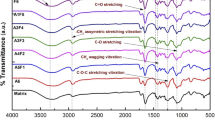Abstract
Fe, Cu, and Ag nanoparticles, as well as Fe/Cu and Fe/Ag bimetallic nanoparticles, have been produced via the electric explosion of wires. The average size, shape, structure, chemical composition, and zeta potential are determined for nanoparticles. The bimetallic nanoparticles have the structure of Janus nanoparticles with a boundary between two metal phases. Samples of consolidated materials are obtained via cold pressing at a pressure of 3 t/cm2 from bimetallic nanoparticles and mixtures of Fe/Cu and Fe/Ag monomolecular nanoparticles. All the samples have antimicrobial properties against gram-negative cells of a Pseudomonas aeruginosa strain and gram-positive cells of a Staphylococcus aureus one. The dissolution rate for iron in a sodium-phosphate buffer solution of the Fe/Cu consolidated samples is significantly higher than that obtained from Fe/Ag nanoparticles and mixtures of nanoparticles.
Similar content being viewed by others
References
I. Gotman, “Characteristics of metals used in implant,” J. Endourol. 11, 383–389 (1997).
T. W. Bauer and G. F. Muschler, “Bone graft materials. An overview of the basic science,” Clin. Orthop. Relat. Res. 371, 10–27 (2000).
F. Witte, “The history of biodegradable magnesium implants: a review,” Acta Biomater. 6, 1680–1692 (2010).
M. P. Staiger, A. M. Pietak, J. Huadmai, and G. Dias, “Magnesium and its alloys as orthopedic biomaterials: A review,” Biomaterials 27, 1728–1734 (2006).
M. Moravej, A. Purnama, M. Fiset, J. Couet, and D. Mantovani, “Electroformed pure iron as a new biomaterial for degradable stets: In vitro degradation and preliminary cell viability studies,” Acta Biomater. 6, 1843–1851 (2010).
M. Schinhammer, A. C. Hanzi, J. F. Loffler, and P. J. Uggowitzer, “Desing strategy for biodegradable Fe-based alloys for medical applications,” Acta Biomater. 6, 1705–1713 (2010).
A. Sharipova, S. G. Psakhie, S. K. Swain, E. Y. Gutmanas, and I. Gotman, “High-strength bioresorbable Fe–Ag nanocomposite scaffolds: Processing and properties,” AIP Conf. Proc. 1683, 020244 (2015).
L. S. Nair and C. T. Laurencin, “Nanofibers and nanoparticles for orthopaedic surgery applications,” J. Bone Jt. Surg. Am. 90, 128–131 (2008).
L. Juan, Z. Zhimin, M. Anchun, L. Lei, and Z. Jingchao, “Deposition of silver nanoparticles on titanium surface for antibacterial effect,” Int. J. Nanomed. 5, 261–267 (2010).
R. Nirmala, F. A. Sheikh, M. A. Kanjwal, J. H. Lee, S. J. Park, R. Navamathavan, and H. Y. Kim, “Synthesis and characterization of bovine femur bone hydroxyapatite containing silver nanoparticles for the biomedical applications,” J. Nanopart. Res. 13, 1917–1927 (2011).
S. Maitre, K. Jaber, J. L. Perrot, C. Guy, and F. Cambazard, “Increased serum and urinary levels of silver during treatment with topical silver sulfadiazine,” Ann. Dermatol. Venereol. 129, 217–219 (2002).
V. K. Poon and A. Burd, “In vitro cytotoxity of silver: Implication for clinical wound care,” Burns 30, 140–147 (2004).
P. K. Lam, E. S. Chan, W. S. Ho, and C. T. Liew, “In vitro cytotoxicity testing of a nanocrystalline silver dressing (acticoat) on cultured keratinocytes,” Brit. J. Biomed. Sci. 61, 125–127 (2004).
J. F. Fraser, L. Cuttle, M. Kempf, and R. M. Kimble, “Cytotoxicity of topical antimicrobial agents used in burn wounds in Australasia,” ANS J. Surg. 74, 139–142 (2004).
F. Delogu, “Thermodynamic phase transitions in nanometer-sized metallic systems,” Mater. Sci. Forum 653, 31–53 (2010).
C. Hock, S. Strassburg, H. Haberland, B. Issendorff, A. Aguado, and M. Schmidt, “Melting-point depression by insoluble impurities: a finite size effect,” Phys. Rev. Lett. 101, 023401 (2008).
A. Barnard, “Modelling of nanoparticles: approaches to morphology and evolution,” Rep. Prog. Phys. 73, 086502 (2010).
M. M. Mariscal, O. A. Oviedo, and E. P. M. Leiva, Metal Clusters and Nanoalloys from Modeling to Applications (Springer, New York, Heidelberg, Dordrecht, London, 2013).
M. I. Lerner, A. V. Pervikov, E. A. Glazkova, N. V. Svarovskaya, A. S. Lozhkomoev, and S. G. Psakhie, “Structures of binary metallic nanoparticles produced by electrical explosion of two wires from immiscible elements,” Powder Technol. 288, 371–378 (2016).
M. I. Lerner, N. V. Svarovskaya, S. G. Psakh’e, and O. V. Bakina, “Production technology, characteristics, and some applications of electric-explosion nanopowder of metals,” Nanotechnol. Russ. 4, 741–757(2009).
X. He, X. Zhang, L. Bai, R. Hang, X. Huang, L. Qin, X. Yao, and B. Tang, “Antibacterial ability and osteogenic activity of porous Sr/Ag-containing TiO2 coatings,” Biomed. Mater. 11, 045008 (2016).
S. K. Friendlander and C. S. Wang, “The self-preserving particle size distributions for coagulation by brownian motion,” J. Colloid Interface Sci. 22, 126–132 (1966).
R. W. Revie and H. H. Uhlig, Corrosion and Corrosion Control, An Introduction to Corrosion Science and Engineering (Wiley, New York, 2008).
Author information
Authors and Affiliations
Corresponding author
Additional information
Original Russian Text © A.S. Lozhkomoev, M.I. Lerner, A.V. Pervikov, S.O. Kazantsev, A.N. Fomenko, 2018, published in Rossiiskie Nanotekhnologii, 2018, Vol. 13, Nos. 1–2.
Rights and permissions
About this article
Cite this article
Lozhkomoev, A.S., Lerner, M.I., Pervikov, A.V. et al. Development of Fe/Cu and Fe/Ag Bimetallic Nanoparticles for Promising Biodegradable Materials with Antimicrobial Effect. Nanotechnol Russia 13, 18–25 (2018). https://doi.org/10.1134/S1995078018010081
Received:
Accepted:
Published:
Issue Date:
DOI: https://doi.org/10.1134/S1995078018010081




